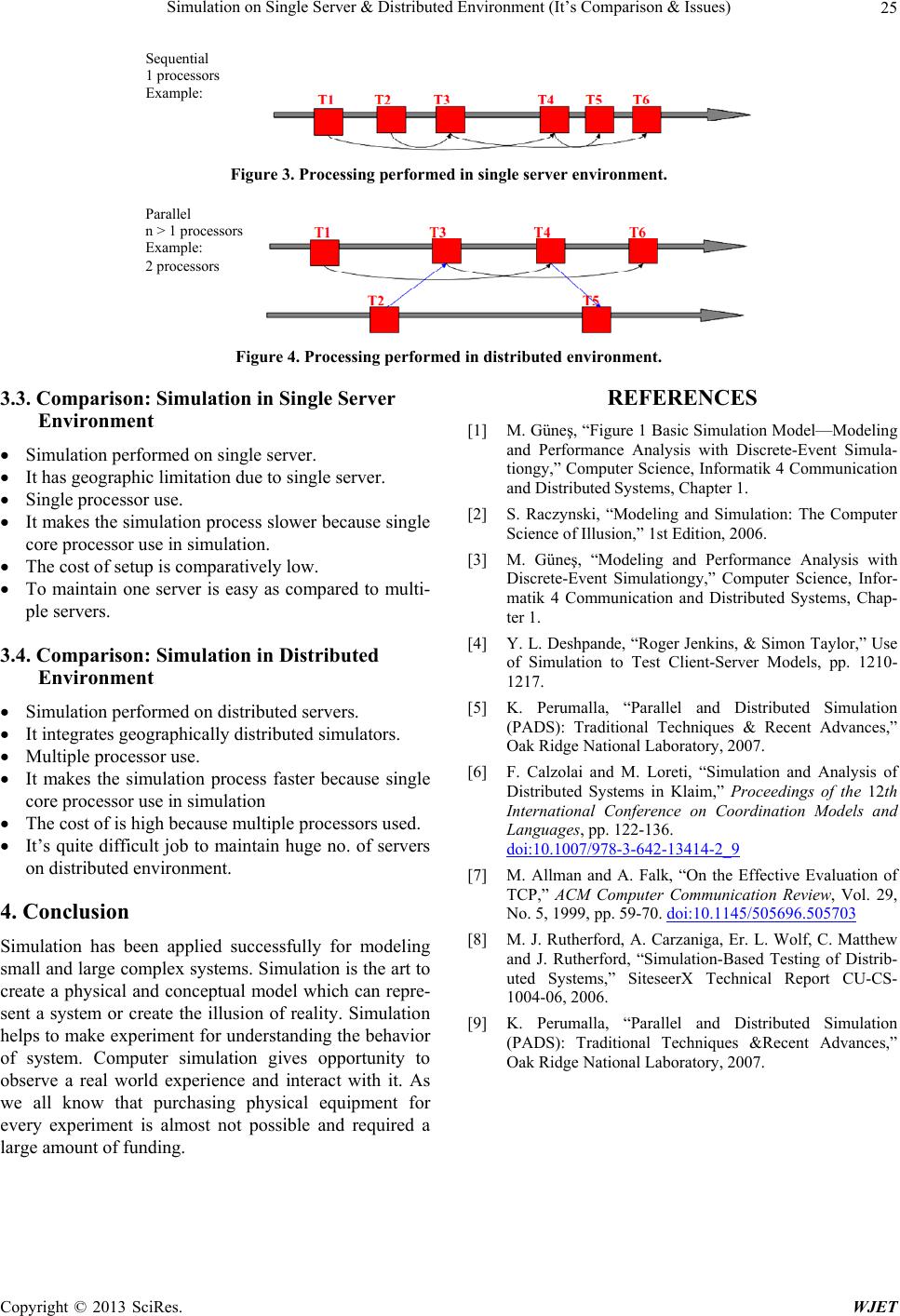
Simulation on Single Server & Distributed Environment (It’s Comparison & Issues) 25
Sequential
1 processors
Example:
Figure 3. Processing performed in single server environment.
arallel
> 1 processors
xample:
processors
Figure 4. Processing performed in distributed environment.
3.3. Comparison: Simulation in Single Server
Environment
Simulation performed on single server.
It has geographic limitation due to single server.
Single processor use.
It makes the simulation process slower because single
core processor use in simulation.
The cost of setup is comparatively low.
To maintain one server is easy as compared to multi-
ple servers.
3.4. Comparison: Simulation in Distributed
Environment
Simulation performed on distributed servers.
It integrates geographically distributed simulators.
Multiple processor use.
It makes the simulation process faster because single
core processor use in simulation
The cost of is high because multiple processors used.
It’s quite difficult job to maintain huge no. of servers
on distributed environment.
4. Conclusion
Simulation has been applied successfully for modeling
small and large complex systems. Simulation is the art to
create a physical and conceptual model which can repre-
sent a system or create the illusion of reality. Simulation
helps to make experiment for understanding the behavior
of system. Computer simulation gives opportunity to
observe a real world experience and interact with it. As
we all know that purchasing physical equipment for
every experiment is almost not possible and required a
large amount of funding.
REFERENCES
[1] M. Güneş, “Figure 1 Basic Simulation Model—Modeling
and Performance Analysis with Discrete-Event Simula-
tiongy,” Computer Science, Informatik 4 Communication
and Distributed Systems, Chapter 1.
[2] S. Raczynski, “Modeling and Simulation: The Computer
Science of Illusion,” 1st Edition, 2006.
[3] M. Güneş, “Modeling and Performance Analysis with
Discrete-Event Simulationgy,” Computer Science, Infor-
matik 4 Communication and Distributed Systems, Chap-
ter 1.
[4] Y. L. Deshpande, “Roger Jenkins, & Simon Taylor,” Use
of Simulation to Test Client-Server Models, pp. 1210-
1217.
[5] K. Perumalla, “Parallel and Distributed Simulation
(PADS): Traditional Techniques & Recent Advances,”
Oak Ridge National Laboratory, 2007.
[6] F. Calzolai and M. Loreti, “Simulation and Analysis of
Distributed Systems in Klaim,” Proceedings of the 12th
International Conference on Coordination Models and
Languages, pp. 122-136.
doi:10.1007/978-3-642-13414-2_9
[7] M. Allman and A. Falk, “On the Effective Evaluation of
TCP,” ACM Computer Communication Review, Vol. 29,
No. 5, 1999, pp. 59-70. doi:10.1145/505696.505703
[8] M. J. Rutherford, A. Carzaniga, Er. L. Wolf, C. Matthew
and J. Rutherford, “Simulation-Based Testing of Distrib-
uted Systems,” SiteseerX Technical Report CU-CS-
1004-06, 2006.
[9] K. Perumalla, “Parallel and Distributed Simulation
(PADS): Traditional Techniques &Recent Advances,”
Oak Ridge National Laboratory, 2007.
Copyright © 2013 SciRes. WJET